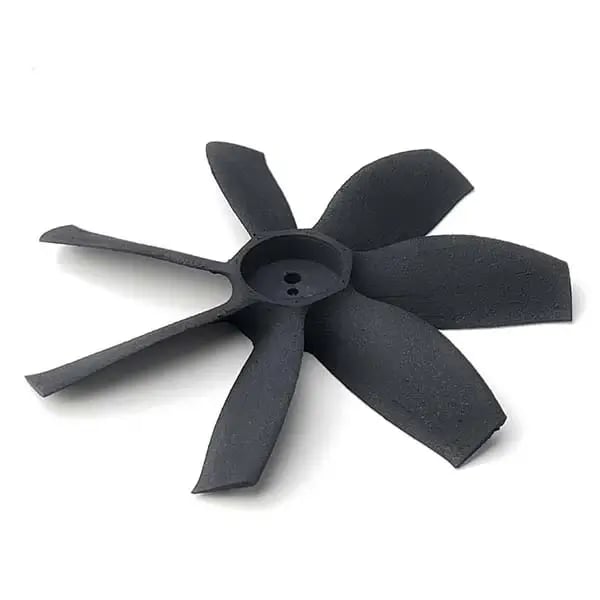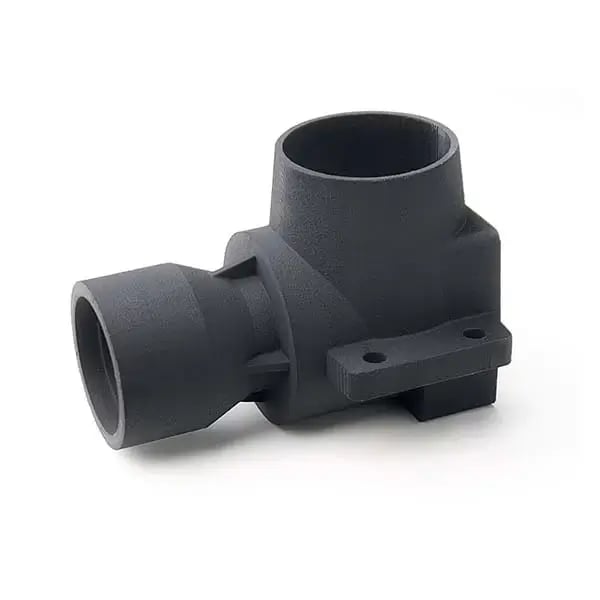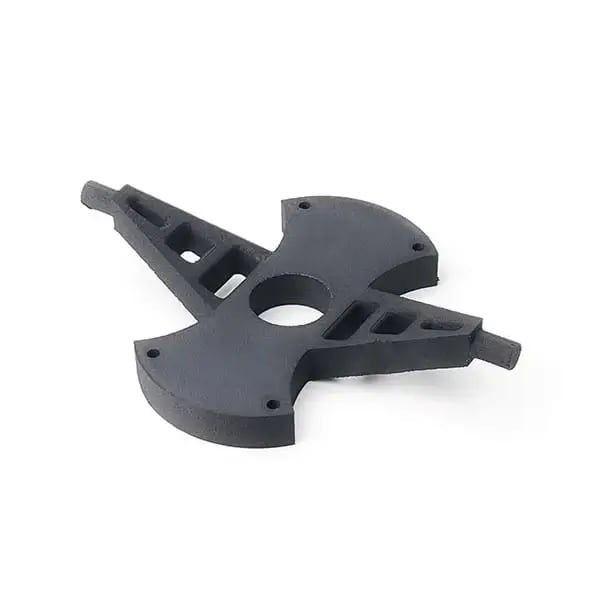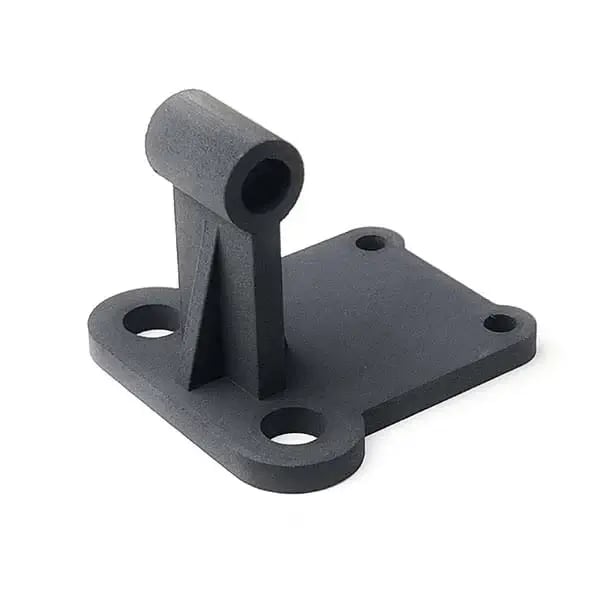Nylon PA6 carbon fiber
Lightweight, strong and ideal for high-performance applications
Carbon fibre-reinforced PA6 nylon is a technical composite that combines high mechanical strength, stiffness, and a low coefficient of friction. It also offers excellent chemical and impact resistance, making it suitable for demanding environments. Its light weight makes it ideal for applications in the aerospace, automotive, and industrial sectors.

PROS
- More flexible than PA12 CF
- Higher elongation at break
- Lightness
- Excellent chemical resistance
- Dimensional stability
CONS
- Difficult to paint
- Layers can be visible
MAIN FEATURES
- 3D printing process: FDM
- Tolerance: < 100mm ± 0,60mm; > 100mm ± 0,75%
- Max size: 300 x 300 x 300 mm; 11,8 x 11,8 x 11,8 in
- Lead time: <3 days
NYLON PA6 CF 3D PRINTING GALLERY
PA6 CF COMMENT
Nylon PA6 CF (Carbon Fiber Reinforced Nylon PA6) is a revolutionary composite material that combines the exceptional properties of carbon fiber with the versatility of nylon. This combination results in a material with superior chemical resistance, low friction and exceptional impact resistance, making it particularly suitable for demanding applications. Carbon fiber, renowned for its extraordinary strength and light weight, gives the material remarkable structural strength, while nylon adds durability and wear resistance.
The light weight of Nylon PA6 CF filament makes it ideal for high-tech industries such as aerospace and automotive, where weight reduction is crucial to improve efficiency and performance. In these areas, the material's impact resistance and stability are essential to ensure the safety and durability of components. Its versatility also makes it suitable for a wide range of other applications, including medical devices and industrial products, where its unique properties can be exploited to improve functionality and efficiency.
Pros
Greater Flexibility than PA12 CF: Nylon PA6 CF is distinguished by its superior flexibility compared to PA12 CF. This results in greater elongation at break, making the material more suitable for applications that require not only strength but also some elasticity. This flexibility is especially useful in components that must absorb shock or stress without breaking, such as in some structural parts in aerospace or automotive applications.
Lightness: The combination of nylon and carbon fiber creates a material that is remarkably light. This lightness is critical in industries such as aerospace and automotive, where reducing weight can mean increasing fuel efficiency and improving overall performance. In addition, weight reduction can lead to greater agility and better handling in various engineering contexts.
Excellent Chemical Resistance: Polyamide PA6 CF is known for its excellent resistance to a wide range of chemicals. This makes it ideal for use in aggressive industrial environments, where materials may be exposed to solvents, oils and other chemicals. It is also advantageous in medical device manufacturing, where resistance to sterilizers and other chemicals is essential.
Dimensional Stability: Another significant advantage of PA6 CF is its dimensional stability. Even under stress or heat conditions, the material retains its shape and size. This property is crucial in applications where dimensional accuracy is critical, such as in precision mechanical components or electronic devices.
Cons
Difficulties in Colouring: Due to the presence of carbon fibre, Nylon PA6 CF can present challenges in colouring. This limits aesthetic options for manufacturers requiring custom colours or specific finishes.
Layer Visibility in 3D Printing: During 3D printing, the layers of the Nylon PA6 CF filament may be more visible than other materials. This can be an aesthetic problem in applications where surface finish is important. However, with appropriate post-processing techniques, it is possible to reduce the visibility of the layers and improve the aesthetic appearance of the finished product.
Applications of Nylon PA6 CF
Aerospace: In the aerospace industry, Nylon PA6 CF is used for the manufacture of components that combine light weight and high strength. This includes not only structural parts of aircraft, but also internal components such as cladding panels and mounts for on-board electronics. Its resistance to fatigue and high temperatures makes it ideal for the extreme environments typical of this sector.
Automotive: In the automotive industry, polyamide PA6 CF finds application in the production of vehicle parts where weight reduction is crucial to improve fuel efficiency and overall performance. This includes components such as engine mounts, chassis components, interior and exterior panels, and even aerodynamic parts such as spoilers and diffusers.
Medical Devices: In the field of medical devices, Nylon PA6 CF is used to create surgical instruments, diagnostic equipment components and prostheses. Its combination of low friction and chemical resistance ensures that devices are safe, durable and easy to sterilise.
Industrial and Consumer Products: PA6 CF is widely used in a variety of industrial and consumer products, such as sports equipment (e.g. bicycle frames, tennis rackets), hand tools and machinery components. Its strength and durability make it suitable for items that are subjected to regular mechanical stress.
Economical Alternative to Metals: Nylon PA6 CF offers a lightweight yet robust alternative to traditional metals such as aluminium and steel in many engineering applications. This material finds use in areas such as robotics, mechanical engineering and machine building, where weight reduction can improve efficiency and reduce operating costs.
Conclusion
Nylon PA6 CF emerges as a composite material of excellent quality, which stands out for its ability to provide an optimal balance of light weight, strength and high performance, even under demanding environmental conditions. Its versatility makes it extremely suitable for a wide range of industrial and technological applications. From aerospace production, where strength and lightness are paramount, to the automotive industry, which requires materials capable of withstanding mechanical and environmental stresses, PA6 CF establishes itself as an ideal choice.
Furthermore, its applicability extends to the medical device sector, where properties such as low friction and chemical resistance are essential to ensure the safety and efficacy of products. Even in the world of consumer products, such as sporting goods and tools, this nylon offers superior performance, combining durability and lightness effectively.
Despite some limitations, such as difficulties in colouring and layer visibility in 3D printing processes, PA6 CF polyamide continues to be an excellent choice in many areas. These challenges are often overcome through innovation in finishing processes and printing technology, allowing manufacturers to take full advantage of its unique properties.
Furthermore, the increasing focus on more sustainable and high-performance materials is driving the industry towards the adoption of solutions such as PA6 CF filament.Its ability to replace heavier and less environmentally friendly materials, such as certain metals, paves the way for a more sustainable and innovation-driven future.
In summary, Nylon PA6 CF represents a significant step forward in the field of composite materials, offering new possibilities in design and production in a variety of sectors. With its unique combination of lightness, strength and stability, it is well positioned to meet the needs of an evolving market where performance and sustainability go hand in hand.
MATERIAL PROPERTIES
| Tensile breaking load | 74,8 MPa |
| Modulus of elasticity | 4500 MPa |
| Elongation at break | 2,5% |
| Flexural modulus | 5224 MPa |
| HDT 0.45 MPa | 155 ºC |
After searching a lot for the perfect material, I finally found the perfect solution in nylon PA6 CF - stiff but not too much, more resistant to impacts, combined with its low friction, allowed me to create the perfect solution for my project.
Questions and answers
Nylon PA6 CF and PA12 CF are high-performance composite materials, both reinforced with carbon fiber, but they have distinctive features that determine their use in different applications. Nylon PA6 CF stands out for its greater flexibility compared to PA12 CF, thanks to its higher elongation at break. This feature gives PA6 CF superior capacity to absorb dynamic loads and deformations without fracture risk, making it particularly suitable for components under variable stress. Additionally, PA6 CF offers significantly higher thermal resistance, making it ideal for use in high-temperature environments or extreme operating conditions. However, these advanced performances come at a cost: PA6 CF is generally more expensive than PA12 CF, an important consideration for budget-constrained projects. On the other hand, Nylon PA12 CF is characterized by its lighter weight, a crucial aspect in industries such as aerospace and automotive, where weight reduction is a priority to improve overall efficiency. PA12 CF is also known for its dimensional stability in variable environmental conditions, such as humid environments, ensuring long-term precision and reliability. These qualities make it particularly suitable for applications requiring a high-performing yet cost-effective material.
Like all nylon-based materials, Nylon PA6 CF can absorb some moisture from the surrounding environment, affecting its dimensional and mechanical properties. However, thanks to carbon fiber reinforcement, this phenomenon is significantly reduced compared to unreinforced nylons. Carbon fiber not only improves the material's stiffness and strength but also acts as a stabilizer, limiting the impact of moisture on the part's volumetric expansion. This feature allows Nylon PA6 CF to maintain high dimensional stability even in challenging operating conditions, such as humid environments or those with temperature and humidity variations. It is particularly advantageous in industrial, automotive, and aerospace applications, where maintaining dimensional tolerances and mechanical performance under prolonged moisture exposure is critical.
Nylon PA6 CF, reinforced with carbon fiber, offers remarkable resistance to high temperatures. According to the material's technical data sheet, its melting temperature is 218.15°C, while its heat deflection temperature (HDT) at 0.45 MPa is 155°C. These values indicate that PA6 CF retains its mechanical and dimensional properties at elevated temperatures, making it suitable for applications in thermally demanding environments. However, it is important to consider that prolonged exposure to temperatures near the HDT could affect the material's performance. For applications requiring superior thermal resistance, alternative materials such as PEEK CF might be more appropriate.
QUOTE IN 1 SECONDS WITHOUT COMMITMENT
How much would my parts made of PA6 CF nylon cost?
upload your 3D and find out now
free instant quote




